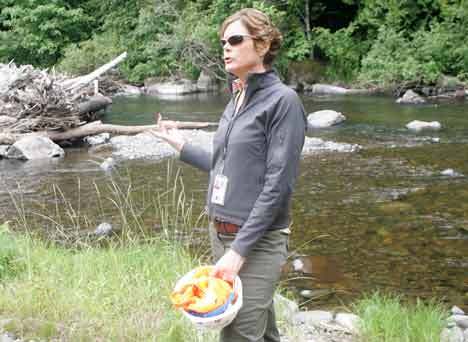Numerous salmon-restoration projects are hatching along the Green River by federal and local governments, in an effort to boost the number of fish in the river.
“We’re trying to make the river better so it’s producing more fish on its own,” said Josh Latterell, a fish ecologist for King County. “If we can help improve areas for spawning and rearing, we can help improve their survival during their time in freshwater.”
Officials from the U.S. Army Corps of Engineers and King County led a Tuesday tour of salmon habitat projects along the Green River for about three dozen government officials and two newspapers.
It’s all part of an effort started in 2005 by 16 local governing bodies to help restore the number of salmon in the Green-Duwamish watershed that stretches from the Puget Sound to the upper Green River beyond the Howard Hanson Dam.
Chinook salmon became federally listed as an endangered species in 1999. Government officials hope the numbers of chinook can be brought up to healthier levels with the restoration projects.
“If we lose the chinook, we would lose a little bit of what makes Seattle, Seattle,” said Alex Murillo, a city of Kent environmental engineer, who took the tour.
With that in mind, work crews have been creating log jams and adding gravel along the Green River to help create more areas for salmon to spawn.
Mamie Brouwer, a salmon habitat project manager for the Corps, showed off a restoration project her agency built six years ago just a few miles downstream from the Hanson Dam.
More than 80 pieces of large, woody debris were installed at two different sites to create log jams. Brouwer expected it might take a few years for salmon to start using the area, but fish showed up in the first year.
“It can take a long time for habitats to look natural and get use,” Brouwer said as she stood on the edge of the river and eyed the log jam. “We had a lot of fish in the first year.”
The Corps also dumps 14,000 tons of gravel a year into the Green River to help create spawning areas. Gravel, in which the fish deposit and fertilize eggs, often gets trapped near the log jams and provides more spawning areas.
“Before construction of the log jam, the bottom was large boulders,” Brouwer said. “There was no opportunity to spawn.”
Salmon begin to show up in mid-September to use the areas around the log jams.
“It spreads out the spawning opportunity for about three to four miles,” Brouwer said. “There are all sorts of salmon around the log jam in September.”
Working on salmon restoration gives Brouwer a nice break from other projects she helps oversee at the Hanson Dam, including the water leak in the right abutment of the structure that showed up in January.
“When I’m tired of talking about concrete, I come out here,” she said. “This is what it’s all about.”
King County as well as the cities of Auburn and Kent also are working on salmon habitat projects along the river.
The Pautzke/Fenster project, a joint effort between the county and Auburn near Highway 18, will provide spawning areas with the addition of woody debris.
The City of Kent plans a salmon habitat project at Riverview Park, just south of the LA Fitness building, to give salmon more areas to survive.
For more information about the Green River-Duwamish watershed and salmon habitat projects, go to www.govlink.org/watersheds.
Talk to us
Please share your story tips by emailing editor@kentreporter.com.
To share your opinion for publication, submit a letter through our website https://www.kentreporter.com/submit-letter/. Include your name, address and daytime phone number. (We’ll only publish your name and hometown.) Please keep letters to 300 words or less.

